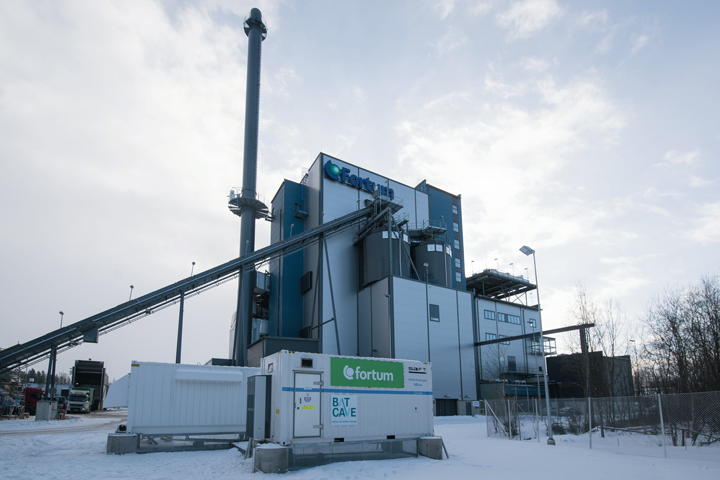The Saft Intensium® Max containerized energy storage system, with a nominal output of 2 MW and 1 MWh of capacity, has been installed at Fortums Järvenpää biomass fired CHP (combined heat andpower) plant.
Saft Li-ion energy storage will maintain the balance of power for Finland's transition to a solar economy
Contributed by | Saft
Fortum, the Finnish energy company, is carrying out the BATCAVE project to explore how energy storage can help balance supply and demand as the country makes the transition from traditional energy production to a solar economy that utilizes renewable resources. The project features the largest ever electricity storage installation in the Nordic countries and is based on the highest power and energy Li-ion system that Saft has ever delivered in a single 20-foot Intensium® Max container.
Fortum’s vision is to be the forerunner in clean energy. It has a number of key objectives for the BATCAVE R&D project. Primarily, it wants to investigate and evaluate how the effective storage of electricity can help it stay on top of changes in electricity markets as they evolve to accommodate more decentralized and intermittent resources. It is also exploring how to best utilize the battery as part of its energy business, starting with offering frequency controlled power reserves (FCR-N) to Fingrid, Finland’s transmission system operator. Finally, the BATCAVE project will act as an extension of Fortum’s pioneering experiments in which it is building a virtual power plant (VPP) based on demand flexibility.
The BATCAVE energy storage offers Fortum’s a number opportunities to achieve long term benefits:
• Reduced costs in hydropower maintenance
• Additional flexible capacity to generate more income
• Combining existing and new income streams with battery technology:
- Primary reserve operations
- Power shifting in other intra-day and day-ahead markets
- Reactive power control
- Power plant support
Energy storage co-located at CHP plant
The Saft Intensium® Max containerized energy storage system, with a nominal output of 2 MW and 1 MWh of capacity, has been installed at Fortum’s Järvenpää biomass fired CHP (combined heat andpower) plant.
Safety and control systems
The Intensium® Max container houses over 6,600 Li-ion cells arranged in 17 individual units. Each unit has an independent monitoring and safety system – the BMM (Battery Management Module). The BMM monitors the temperature, voltage and current of each cell and interfaces with the MBMM (Master Battery Management Module) to provide real-time informationon key operational criteria such as the battery temperature, state of charge (SOC) and state of health (SOH). This focus on monitoring enables Saft to guarantee safe behavior at every level from cell to container.
The entire battery and power conversion system can be controlled remotely from Fortum’s central control room. Local control is also possible by Fortum’s battery controller system.
Fortum Intensium ® Max - key features
• 1 x Intensium® Max container
• 6,664 lithium-ion (Li-ion) cells
• 1 MWh storage capacity
• 2 MW peak power in both directions
• Capable of charging from zero to fully-charged in 30 minutes
• HVAC system maintains optimum operating temperature even when outside temperature falls to -20°C
• Schneider ESS Box 2040 kVA power conversion system with 3 XC680ES inverters
Tatu Kulla, Fortum Head of Operations, says:
“Increasing the amount of energy produced with solar and wind power will increase the need for regulating power that balances the electricity network and for new storage solutions. When the weather is sunny or windy, there is plenty of energy production, but less demand, so it makes sense to store the electricity. In this project, we are also researching new business models that can be developed with storage for electricity companies and customers.”
The content & opinions in this article are the author’s and do not necessarily represent the views of AltEnergyMag
Comments (1)
Featured Product


